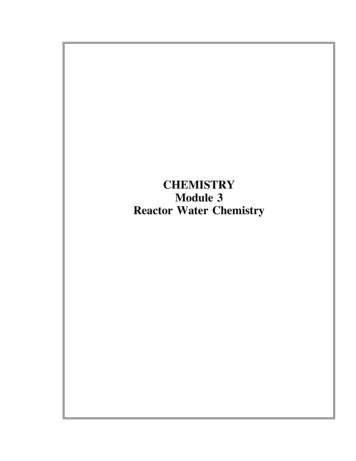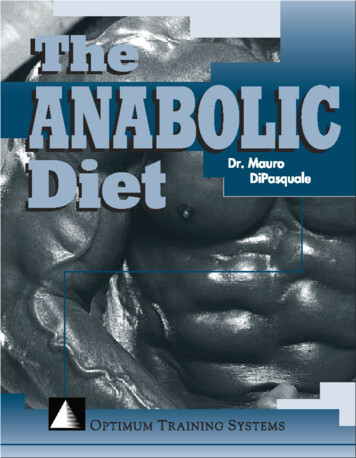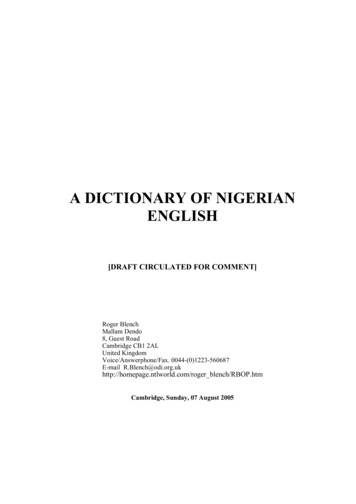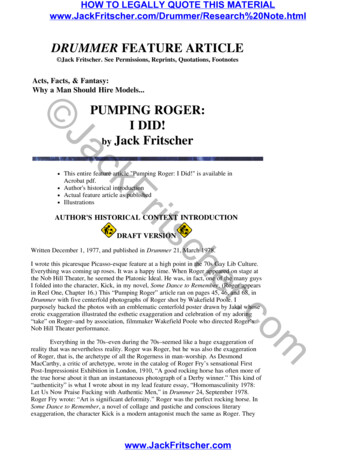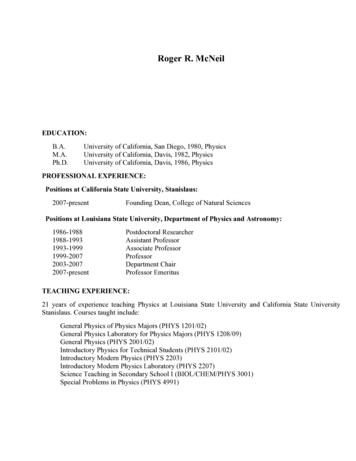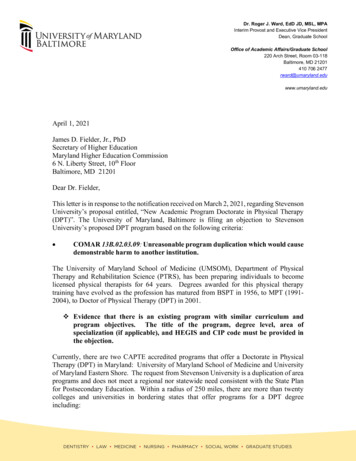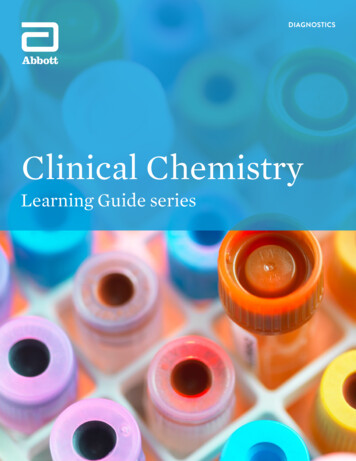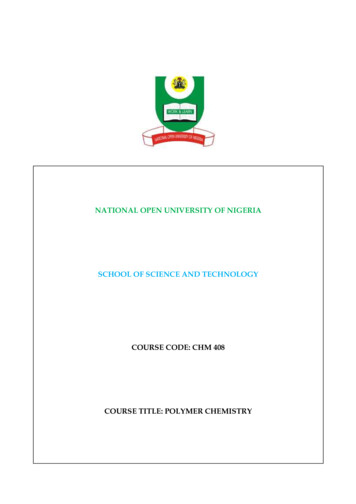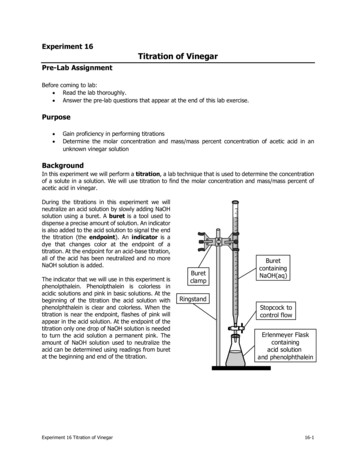
Transcription
Roger NorrisCambridge International AS and A LevelChemistryWorkbook
University Printing House, Cambridge CB2 8BS, United KingdomOne Liberty Plaza, 20th Floor, New York, NY 10006, USA477 Williamstown Road, Port Melbourne, VIC 3207, Australia4843/24, 2nd Floor, Ansari Road, Daryaganj, Delhi – 110002, India79 Anson Road, #06–04/06, Singapore 079906Cambridge University Press is part of the University of Cambridge.It furthers the University’s mission by disseminating knowledge in the pursuit ofeducation, learning and research at the highest international levels of excellence.Information on this title: education.cambridge.org Cambridge University Press 2016This publication is in copyright. Subject to statutory exceptionand to the provisions of relevant collective licensing agreements,no reproduction of any part may take place without the writtenpermission of Cambridge University Press.First published 201620 19 18 17 16 15 14 13 12 11 10 9 8 7 6 5 4 3 2Printed in Italy by Rotolito Lombarda S.p.A.A catalogue record for this publication is available from the British LibraryISBN 978-1-316-60062-7 Paperback with CD-ROM for Windows and Mac Cambridge University Press has no responsibility for the persistence or accuracyof URLs for external or third-party internet websites referred to in this publication,and does not guarantee that any content on such websites is, or will remain,accurate or appropriate. Information regarding prices, travel timetables, and otherfactual information given in this work is correct at the time of first printing butCambridge University Press does not guarantee the accuracy of such informationthereafter.notice to teachers in the ukIt is illegal to reproduce any part of this work in material form (includingphotocopying and electronic storage) except under the following circumstances:(i) where you are abiding by a licence granted to your school or institution by theCopyright Licensing Agency;(ii) where no such licence exists, or where you wish to exceed the terms of alicence, and you have gained the written permission of Cambridge UniversityPress;(iii) where you are allowed to reproduce without permission under the provisionsof Chapter 3 of the Copyright, Designs and Patents Act 1988, which covers,for example, the reproduction of short passages within certain typesof educational anthology and reproduction for the purposes of settingexamination questions.The questions and mark schemes that appear in this Coursebook and accompanyingCD-ROM were written by the authors. In examination, the way marks would beawarded to questions like these may be different.
How to use this bookHow to use this bookA Chapter outline appears at the start of every chapter to set the scene and to help with navigationthrough the bookChapter outline Relative atomic mass, isotopic mass and formula mass based on the 12C scaleEmpirical formula and molecular formulaUsing mass spectra to calculate relative atomic massConstructing balanced equationsPerforming calculations involving moles, reacting masses, gas volumes and solution concentrationA list of Key terms are defined and explained clearly at the start of each topicKEY TERMSiiiAtomic orbitals: Regions of space outside the nucleus occupied by a maximum of two electrons.The s, p, d and f orbitals have different shapes.Electronic configuration: Way of showing the arrangement of electrons in an atom, e.g. 1s22s22p5.Energy levels (of electrons): Regions at various distances from the nucleus where electrons haveparticular amounts of energy. The further the energy level is from the nucleus, the greater the amountof energy it has.Ionisation energy, ΔHi1: The first ionisation energy is the energy needed to remove 1 mole of electronsfrom 1 mole of atoms of an element in the gaseous state to form 1 mole of gaseous ions. Successiveionisation energies refer to further electrons being removed, ΔHi2, ΔHi3, etc.Principal quantum shells: The main energy levels in the atoms where electrons have particular amountsof energy. The first quantum shell can hold a maximum of 2 electrons, the second 8 and the third 18.Shielding: The ability of inner shell electrons to reduce the effect of the nuclear charge on outer shellelectrons.Subshells: Regions of the principal quantum shells where electrons exist in defined areas associatedwith particular amounts of energy.
Cambridge International AS and A Level ChemistryEach Exercise in every chapter helps students to practise the necessary skills for studyingChemistry at AS and A LevelExercise 3.1 Electron shells and subshellsThis exercise is designed to support your understanding of electron shells andsubshells. It also gives practice at deducing and interpreting electron configurations.a The table gives information about electron shells and atomic orbitals. Deduce the numbers andtypes of atomic orbitals represented by the letters A to F.principal quantumshellmaximum number ofelectrons in principalquantum shellnumber of subshellsin principal quantumshelltypes of orbitalpresent1A1B28C2s, 2p3DEFDetailed Learning support is provided throughout to help students tackle the differentexercises and build confidence to answer questions independently.Part (b) asks you to interpret graphs. Remember:iv Rate is proportional tochange in amount of product made (or reactant used up).time Read the stem of the question carefully to get important pieces of information.Exam-style questions allow students to thoroughly prepare for examinations and checkanswers which are provided on the CD-ROM at the back of the book.Exam-style questionsQUESTION 1Hydrogen peroxide decomposes slowly at r.t.p. The reaction is exothermic.2H2O2(aq) 2H2O(l) O2(g)a How is the rate of reaction affected by each of the following conditions? In each case give anexplanation in terms of collision theory or activation energy.iDecreasing the temperature.[2]ii Increasing the pressure.[2]iii Adding a catalyst.[2]
ContentsContentsChapter 1 Moles and equations1Chapter 2 Atomic structure8Chapter 3 Electrons in atoms12Chapter 4 Chemical bonding19Chapter 5 States of matter27Chapter 6 Enthalpy changes37Chapter 7 Redox reactions45Chapter 8 Equilibrium51Chapter 9 Rates of reaction60Chapter 10 Periodicity67Chapter 11 Group 275Chapter 12 Group 1781Chapter 13 Nitrogen and sulfur88Chapter 14 Introduction to organic chemistry95Chapter 15 Hydrocarbons105Chapter 16 Halogenoalkanes114Chapter 17 Alcohols, esters and carboxylic acids119Chapter 18 Carbonyl compounds126Chapter 19 Lattice energy133Chapter 20 Electrochemistry139Chapter 21 Further aspects of equilibria150Chapter 22 Reaction kinetics159Chapter 23 Entropy and Gibbs free energy169Chapter 24 Transition elements176Chapter 25 Benzene and its compounds184Chapter 26 Carboxylic acids and their derivatives191Chapter 27 Organic nitrogen compounds197Chapter 28 Polymerisation204Chapter 29 Analytical chemistry211Chapter 30 Organic synthesis220Chapter P1 and P2 Practical skills226Glossary233Appendix 1240Terms and conditions of use for the CD-ROM243v
Chapter 1Moles and equationsChapter outline Relative atomic mass, isotopic mass and formula mass based on the 12C scaleEmpirical formula and molecular formulaUsing mass spectra to calculate relative atomic massConstructing balanced equationsPerforming calculations involving moles, reacting masses, gas volumes and solution concentrationKEY TERMSAvogadro constant, L: The number of defined particles (atoms, ions, molecules or electrons) in amole of those particles. Its value is 6.02 1023.Empirical formula: The simplest ratio of the different atoms present in a molecule.Mass spectrometer: An instrument for helping to deduce the relative isotopic abundance of elementsand the structure of compounds.Molar gas volume: The volume of one mole of gas at a defined temperature and pressure. At r.t.p. itsvalue is 24.0 dm3.Molar mass: The mass of a mole of substance in grams.Mole: The amount of substance that has the same number of particles (atoms, ions, molecules orelectrons) as there are atoms in exactly 12 g of the 12C isotope.Molecular formula: The actual number of each type of atoms in a molecule.Relative atomic mass: The weighted average mass of the atoms of an element on a scale on which anatom of the 12C isotope has a mass of exactly 12 units.Relative formula mass: The weighted average mass of one formula unit of a compound measured ona scale on which an atom of the 12C isotope has a mass of exactly 12 units.Relative isotopic mass: The mass of a particular isotope of an element on a scale on which an atomof the 12C isotope has a mass of exactly 12 units.Relative molecular mass: The weighted average mass of a molecule on a scale on which an atom ofthe 12C isotope has a mass of exactly 12 units.r.t.p.: Room temperature and pressure (1 atmosphere and 20 C).Spectator ion: Ion present in a reaction mixture which does not take part in the reaction.State symbol: Symbol placed after each reactant and product to indicate whether they are solid (s),liquid (l), gas (g) or in aqueous solution (aq).Stoichiometry: The mole ratio of the reactants and products in a chemical equation.Exercise 1.1 DefinitionsThis exercise will familiarise you with some important definitions about relativemasses, moles and the Avogadro constant.It is important that you learn definitions carefully. Remember that: A mole is an amount of substance.You compare this amount with an atom of the 12C isotope.Relative atomic masses are weighted averages.1
Cambridge International AS and A level ChemistryCopy and complete these sentences using words from the ogadrorelativecarbon-12twelveconstantweightedA mole is theof substance that has the same number of defined particles asin exactlygrams of thethere are.isotope. This number of particles is called theaverage mass of atoms of an element on theRelative atomic mass is thehas a mass of 12 units. Relative molecularscale where an atom of the 12Ctogether themass is found bycompounds we use the termmasses of the atoms in a compound. Forrelative formula mass. Another term is molar mass which is the mass of a.of substance inExercise 1.2 Mole calculationsThis exercise will familiarise you with some basic calculations using the moleconcept. 2mass (in g ).molar mass (in mol dm )In part (a) remember to use the mole ratio.In part (a)(iv) you need to rearrange the equation: (mass (in g) moles molar mass(in mol dm 3).moles a Lead oxide, Pb3O4, is reduced by heating with excess carbon.Pb3O4 4C 3Pb 4COUse the following method to calculate the maximum mass of lead formed when 41.12 g of Pb3O4is reduced.Calculate:i The molar mass of Pb3O4 (Ar values: Pb 207.2, O 16.0).The number of significant figures in your answer should be the same as the leastnumber of significant figures in the data.326.7 is to 4 significant figures.0.014 is to 2 significant figures.ii The amount in moles of Pb3O4 (to 3 significant figures).iii The amount in moles of lead produced.iv Mass of lead produced (to 3 significant figures).b 35.61 g of tin, reacts with exactly 42.60 g of chlorine, Cl2, to form 78.21 g of tin(IV) chloride, SnCl4.iCalculate the number of moles of tin, chlorine and tin chloride. (Ar values: Sn 118.7,Cl 35.5)ii Deduce the stoichiometry of the reaction.iii Write a balanced equation for the reaction.
Chapter 1: Moles and equationsExercise 1.3 Deducing formulae and compositionby massThis exercise will help you deduce empirical formula and molecular formula as well aspercentage composition by mass.Remember that % by mass atomic mass number of moles of elementmolar mass of compounda When 14.98 g of arsenic are completely combusted, 19.78 g of an oxide of arsenic are formed.CalculateiThe mass of oxygen in this oxide of arsenic.ii The amount in moles of atoms of arsenic and oxygen which combine. (Ar values: As 74.9,O 16.0)iii The empirical formula.b The molar mass of this oxide of arsenic is 395.6 g. Deduce the molecular formula of this oxide ofarsenic.c The empirical formula of another oxide of arsenic is As2O5.Calculate the percentage by mass of arsenic in As2O5. Give your answer to 3 significant figures.Exercise 1.4 Using molar gas volume3This exercise helps you use the molar gas volume to deduce the stoichiometry of areaction.Remember that: The volume of one mole of gas at r.t.p. is 24 dm3.volume (in dm ) volume (in cm )Moles of gas or.24 00024a Deduce the volume, number of moles or mass of gas represented by the letters A to F. (Ar values:P 31.0, O 16.0, S 32.1, H 1.00)gasvolume of gas80.0 cmPH333SO2C dmO2E cm3moles of gas / molmass of gas / gABD8.00 g0.150 molFb Two syringes are set up as shown.A40 cm3 oxygen, O2TapB40 cm3 nitrogen(II) oxide, NO
Cambridge International AS and A level ChemistrySmall measured volumes of oxygen were pushed from syringe A into syringe B. The product isanother gaseous oxide of nitrogen, NOy. After each addition of oxygen, the tap was closed andthe total volume of gases measured. The results are shown below.Total volume of gas / cm3806040200i4102030Volume of oxygen reacted / cm340What volume of oxygen reacts with 40 cm3 of nitrogen(II) oxide?ii What volume of NOy is formed?iii Deduce the formula of NOyiv Write a balanced equation for the reaction.Exercise 1.5 Solution concentrationThis exercise gives you practice in calculating volumes, moles and concentrations. Italso revises calculations from titration results.Remember that: amount (in mol).volume (in dm )In some questions you will have to rearrange this equation.Concentration (in mol dm 3) a Deduce the values represented by the letters R to V. (Ar values: Na 23.0, O 16.0, Cl 35.5,H 1.0)solutemoles or massof solutevolume of solutionconcentrationof solutionCuSO40.12 mol200 cm3RHClS mol1.5 dm30.4 mol dm 3ZnCl20.25 molT cm30.05 mol dm 3NaOHNaCl5.4 gVg150 cm3U32.0 mol dm 30.20 dm
Chapter 1: Moles and equationsb 20.0 cm3 of a solution of barium hydr
Chapter 14 Introduction to organic chemistry 95 Chapter 15 Hydrocarbons 105 Chapter 16 Halogenoalkanes 114 Chapter 17 Alcohols, esters and carboxylic acids 119 Chapter 18 Carbonyl compounds 126 Chapter 19 Lattice energy 133 Chapter 20 Electrochemistry 139 Chapter 21 Further aspects of equilibria 150 Chapter 22 Reaction kinetics 159

